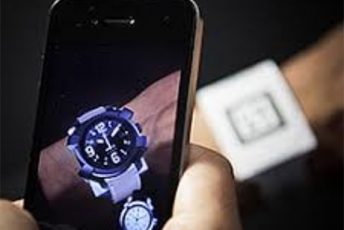With the thrilling debut of the new Wechat Hardware Framework on the 2020 WeChat Public Lecture, we received many inquiries for additional information to this new opportunity to expand the WeChat ecosystem. According to the WeChat announcement, WeChat Hardware Framework for Mini Program is still a demo feature that is not available to the general public.
However, this does not stop us from reading between the lines of the presentation and taking one step further to imagine some of the applicable cases for this new feature.
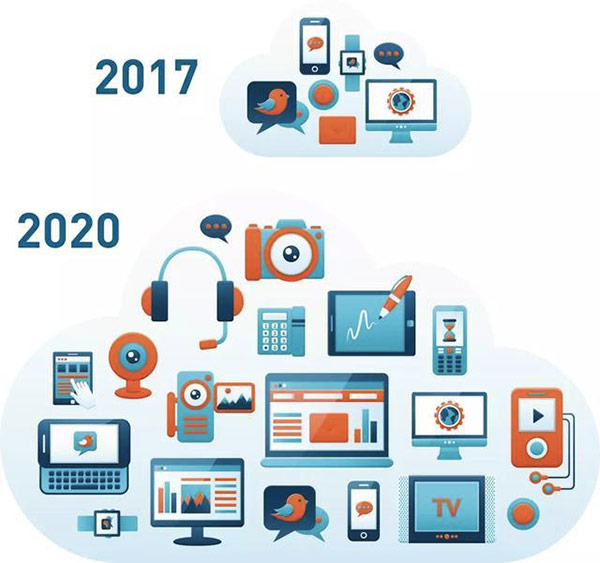
So what exactly is WeChat Hardware Framework?
Introduction of the WeChat Hardware Framework
What is the WeChat Hardware Framework for Mini Program?
The WeChat Hardware Framework is an operating environment that allows hardware to run WeChat Mini Program (MP) in an environment without the WeChat APP on other terminals and hardware devices.
At present, hardware devices that support Android systems can support this WeChat Hardware Framework.
WeChat is always the pioneer to create new needs for its users. When BATB (Acronyme for Baidu – Alibaba – Tencent – Bytedance) started to build their own Mini Program to catch up with this WeChat innovation. However, WeChat is taking one leap further again by expanding the hosting device for Mini Program from smartphone to all Android devices.
With more hardware devices, we can foresee the ambition of WeChat to revolutionise the traditional application format.
It is worth mentioning that although the Hardware Framework currently only supports the Android platform, the WeChat team has taken into consideration to run the WeChat Hardware Framework on other desktop platforms such as Windows and Linux when working on the architecture design in the future.
There are limited amounts of smart devices to access the internet in the past. Now we can see the Hardware Framework as an ambitious expansion to turn the WeChat Mini Program to an omnichannel tool. Android devices are becoming the new terminal of WeChat Mini Program, and more operating systems will be.
Tencent will open up the technical capabilities of WeChat Hardware Framework as a general application development feature. As a result, developers can enjoy convenience while expanding the service scope outside of the WeChat mobile App.
These are one of the core values when comparing WeChat Hardware Framework with other cross-platform application development solutions. The cross-platform consideration brings more possibilities for current WeChat MP developers to tap into the massive users in the WeChat eco-system, from online to offline, from small screens to large screens, from people-to-things and end-to-end solutions.
WeChat Hardware Framework Key Features List
Running WeChat Mini Program on WeChat Hardware Framework will provide similar functionality as the WeChat Mini Program on mobile APP.
Below is a list of interesting features of WeChat Hardware Framework that provide future opportunity.
The full list of BETA features is summarised in the official documentation.
Released BETA features
These features are specific to the WeChat Mini Program Hardware Framework.
| WeChat Mini Program Hardware Framework SPECIFIC features | Description |
| 消息push能力(无条件限制,但一个月内至少启动一次小程序) Message notification | Unlimited numbers to push notifications to the users. The timeframe is 1 month since the Mini Program last open. |
| 打印机 Printer | Hardware Framework can connect to the printer directly. |
| 无微信客户端时,手机客户端扫码支付 Using WeChat scan to pay feature without WeChat APP environment | Normally the WeChat Pay can only work within WeChat ecosystem with connection to the WeChat Open Platform. This feature breaks down the above-mentioned limitation and provides wide use of WeChat Pay in more area. |
| 合作方可决定小程序是否同步出现在手机端里 Mini Program can be published only for the hardware devices and not visible for the smartphone users only | It’s the reason for some Mini Program to be used specifically on certain Hardware devices only. With the limiting ability, brands can publish more Mini Program for different usages and limit them for internal use |
Features to be released in the next iterations of the WeChat hardware framework for Mini Program
| WeChat Mini Program Hardware Framework COMING SOON features | Description |
| 内嵌 web–vive网页 Embed web-view pages into Mini Program | The feature allows the Mini Program to display mobile-friendly web pages on hardware devices. This helps to reduce the cost to replicate the same features on the website onto the Mini Program environment. |
| 横屏中居中显示竖屏小程序 Displaying vertical Mini Program in the center on a horizontal screen | Currently, the developpers still need to write responvice code in order to allow the vertical Mini Program to be displayed on the horizontals smart screens. |
| 3D人脸登录、支付 3D facial recognition for login and payment | This feature allows the user to login and makes a payment just by scanning the face. |
Main Use Cases & Demo
The WeChat Hardware Framework can be applied to any hardware interface with the Android systems, such as tablet computers and large screen devices in various industries.
This ultimately provides a low-cost touchscreen interactive solution. Accessible devices include, but are not limited to the following:
Smart retail
In-Store registration & payment / Loyalty Program binding with WeChat Account / Product Catalog Showcase / Augmented Reality touchscreen in-store / Virtual Reality / Ticketing machine / In-mall directory / Vending machine / Order Management System / Interactive advertising screen, etc …
Event & Marketing
- Event Registration & check-in
- Interactive Campaign at the event
- etc …
Home and Entertainment Equipment
Learning Management System / Fitness & Gym Equipment / Smart Refrigerator / Smart TV / KTV / Audio & Streaming, Cinema ticket / etc …
Public services
Hospital & Clinic registration machine / Booking Engine & Queuing system / Public transportation services, etc.
Office life
Education tablet / Conference call / Check-in / WeChat Work / etc …
Application scenario 1: Shopping mall directory
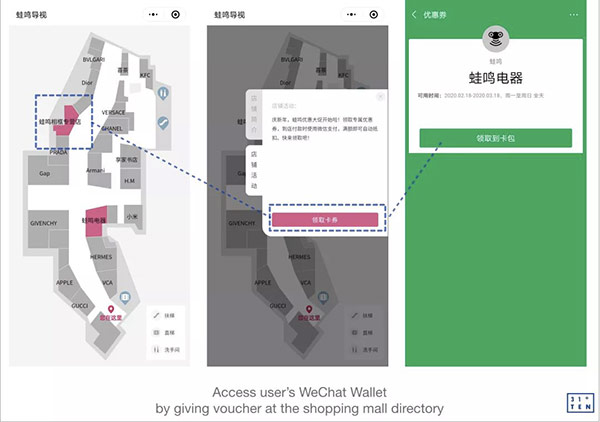
In the scenario of applying Hardware Framework on the directory machine in the shopping malls, Mini Program is able to transform the drop-down entry centre for MP on the mobile phone to map of the mall.
When the user clicks on one of the shops on the map, the user can be redirected seamlessly to browse the MP of that particular retailer and receive vouchers.
From the map directory to the brand-owned MP, the user can view the relevant activity and information about the brand before deciding if that is the store he wants to visit. Also vouchers for the shops can be given at the directory after the user registered themselves at the directory screen.
Application scenario 2: Meeting room booking
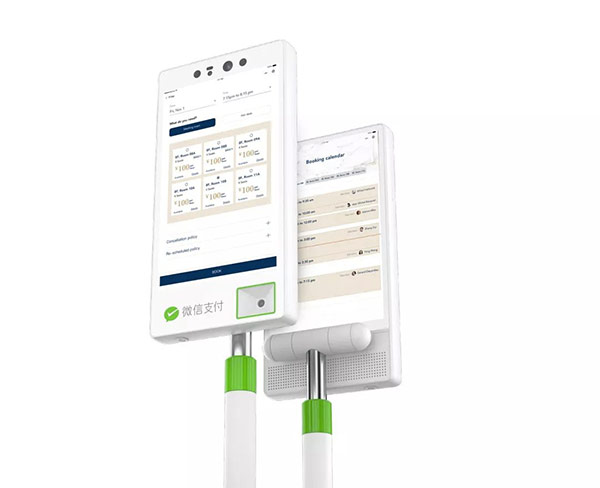
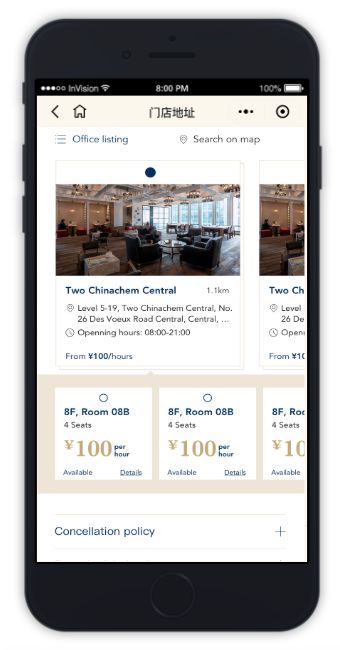
At present, although it is possible to register online or make reservations for medical visit on-site on the touchscreen in a hospital, the hardware facilities and built-in systems provided by major medical institutions are developed by different providers.
This introduces troubles with data synchronizations for an individual patient from different hardware devices for electronic medical records, health files, and patient purchase information.
However, the WeChat Mini Program Framework guarantees data sharing and breaks down the barriers of information silos in traditional medicine.
As a result, the patient can create user files in a mini-program to link the information across provinces, hospitals, and terminals, medical files for patients can be obtained.
Key Advantages for Developers, Retailers, End-users
For developers
Low development costs
Developers no longer need to invest in high costs to develop, maintain or update the APP. Mini-programs can be updated online, that is, more ready to use.
Rich content ecology
WeChat mini-program ecosystem has a wealth of existing content and services. The hardware can directly run as a normal mini-program on the existing network to provide users with comprehensive services.
WeChat connection capability
WeChat ecosystem empowers the hardware, through WeChat authorized login, users can collect rich user portrait information. And through WeChat sharing capabilities, service content can be fissioned and spread within WeChat.
The service subscription notification message can reach the user in one step, and the payment of the coupon can make the user’s value more realizable.
For retailers
More service capabilities and WeChat access options are available on-demand to enhance brand awareness. After connecting to the WeChat ecosystem, it is more conducive to reaching users and private marketing.
Hardware Framework comes with an embedded feature to ensure the smooth data flow within the WeChat Ecosystem. This framework helps the retailers to track customer purchasing habits and easily construct the customer portrait.
It is even possible for the MP to link with the CRM system to predict the consumer’s preferences and provide suggestions to the shop assistant based on the customers’ past taste purchases.
Retailers can use the Hardware Framework to integrate features from different providers, for example, integrate A’s POS system, B’s membership software, and C’s electronic invoice into 1 central Mini Program. In this way, the centralised Mini Program can provide services to customers in multiple scenarios. Retailers now have more choices and are no longer limited to the software provided by the hardware equipment.
The investment to have such a solution will be minimal for the retailers. Most of the existing MP can be implemented on different hardware devices easily with this WeChat Hardware Framework. The additional cost will only to ensure the compatibility rather than building a new solution from scratch.
For end-users
With the powerful WeChat ecosystem, users can easily implement WeChat login, sharing, and payment operations on different hardware devices, and enjoy a consistent experience with the WeChat native app.
All information and user activity for the end-user on different platforms can be assigned to one individual. Features such as address book, login information and sharing to friends can be done on different platforms securely. Because this information is linked with an individual WeChat account.
How much would that cost?
As you could see on Nivose demo (👇👇👇👇), showing product catalogue in their flagship stores or popup store and could be relevant in their cases to showcase the full catalogue on the tablet to also get more information about the product or the brand.
If Nivose wants to set up this Mini Program Hardware Framework in one of their shops as a pilot test. How much would that cost?
| SCOPE OF WORK (1 time fee) | BUDGET |
| Convert & Adapt a WeChat Mini Program to a Mini Program Hardware Framework Build: Design / Development / Analytics Setup | 5% to 50% of the whole WeChat Mini Program time depending on your needs |
| Hardware cost: 12.9 inches tablet / interactive screens (Android only) | 1 device: 1,000 to 10,000 RMB |
| Hardware equipment: Support / Stand for the tablet | 1 support: 50 to 1,000 RMB |
| Optional: Connection to POS if payment, notification, etc… | TBD |
Conclusion on the WeChat Hardware Platform
- Operate Mini Program not only on your smartphone
- WeChat Mini Program turning omnichannel.
- Ease in development and compatibility
- Hardware framework only works on Android hardware devices now, but more will come.
- Coming soon features that will bring this framework to another level (3D facial recognition for login and payment)
Further readings
- 小程序硬件框架(WMPF)[WeChat Documentation]
- 微信小程序跨终端运行,万物互联的时代真的来了!| January 2020 [baijiahao]
- 微信小程序框架(WMPF)发布:可脱离微信客户端,支持安卓设备 | January 2020 [ithome]
- 小程序硬件框架正式上线 | January 2020 [大话软件]
- 微信小程序硬件框架快速体验demo已上线 | February 2020 [wecooper]
- 脱离微信,在硬件设备运行小程序?小程序硬件框架大揭秘!
| January 2020 [CSDN] - 重磅 | 微信小程序可以在智能设备上运行了,它可以带来哪些改变?| January 2020 [知晓程序]


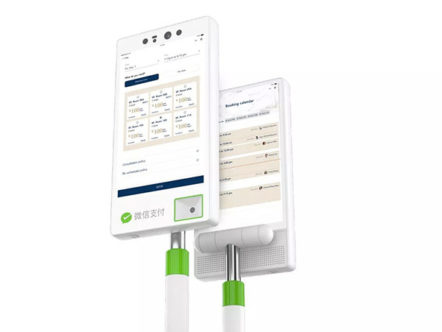
![[Augmented Reality (AR) on WeChat] WeChat Mini Program AR shopping experience](https://wechatwiki.com/blog/wp-content/themes/johannes/assets/img/johannes_default.jpg)
